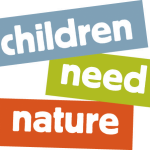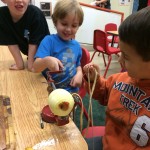 By Shannon Dryden, Preschool Manager and Sweet Gum Classroom Lead Teacher
By Shannon Dryden, Preschool Manager and Sweet Gum Classroom Lead Teacher
The beginning of the year at preschool means apples! For most preschools, this is also the case, but at Schuylkill Center Nature Preschool, an interest in apples developed from enjoying apples snacks to the preschoolers’ observations along the trails. Playing and exploring outside led to a deeper association with apples.
 As both classes walked along various trails (getting to know our outdoor community), they started classifying the types of trees with their teachers’ help, by looking at the shape of the leaves, the bark, and branches. Inspired by the changing colors and fall, the children have also been talking about activities like apple picking, visiting a farm, and going on nature hikes with their families. We noticed children bringing in apples at lunch, which sparked conversations about where apples come from. This gave the class an idea – let’s visit the orchard. What you may not know is that the Schuylkill Center property includes a small intimate crab apple orchard that blossoms with color and fruit this time of year.
As both classes walked along various trails (getting to know our outdoor community), they started classifying the types of trees with their teachers’ help, by looking at the shape of the leaves, the bark, and branches. Inspired by the changing colors and fall, the children have also been talking about activities like apple picking, visiting a farm, and going on nature hikes with their families. We noticed children bringing in apples at lunch, which sparked conversations about where apples come from. This gave the class an idea – let’s visit the orchard. What you may not know is that the Schuylkill Center property includes a small intimate crab apple orchard that blossoms with color and fruit this time of year.
We asked the children what an orchard was and they shared many ideas including, “it’s a group of trees” or “I’ve been to an orchard. There are apples there!” We continued to guide the children in critical thinking by asking, “Where do apples come from?” Using this new interest in apples, we led the children through a special cooking activity for Back to School Night. We followed a recipe and enjoyed measuring, scooping, pouring, and mixing the ingredients. Each class used an apple peeler and corer and combined cinnamon and apples in a crock pot to create applesauce.
As much as it was fun, making applesauce was also an examination of changes in states of matter as the children collaborated in the cooking process. After hearing all of these observations and stories about apples, we all felt ready for our longest hike yet, to the orchard for more research. When we reached the orchard, the children immediately began carefully picking crab apples off the trees, gathering them from the ground, and counting the bountiful fruit. The children were drawn to this small version of apples and even took a few bites, showing a squeamish face at the sour taste! Equipped with questions and ideas, the children were inspired to continue exploring apples.
We saw how much the children enjoyed tasting and took this opportunity to guide the children through classifying and grouping with food. We were ready to be researchers and participate in a taste test. First, we examined different types of apples, named them (Golden Delicious, Granny Smith, Red Delicious, Lady, and Gala), and then tasted, and graphed our favorites! The children used words such as “sour,” “sweet,” “crunchy,” and “delicious” as they took bite after bite. Each child was excited to chart their favorite, carefully coloring in the block for the apple they chose. We counted each category of apple and identified the favorite and least favorite for each group.
Apples were also inspiration for sketches, drawings, and paintings. The children made drawings of the apple of their choice, using color, line, and technique to record what they saw. It was very exciting to hear the children talk about the skin, where the core was, and why the apples had a stem. The children rolled crab apples in paint along a tray and created a beautiful display of patterns and color. This was also an experience with cause and effect as the children noticed the way they turned the tray affected which way the apples would roll. These activities informed the children by helping them to make connections with the fruit. Now that the children had become the drivers of the apple study, they were empowered as “apple experts.”
The preschoolers learned about the interdependence of the environment and people on each other through this hands-on learning. By having these experiences, the children were internally motivated to understand how to care for our ecosystem and what their own role is. This is a beginning step in developing ecological awareness, which will continue to mature as the children explore what is in their immediate ecosystem.
Children Need Nature is a monthly blog column from our Nature Preschool program. Read more posts here.
